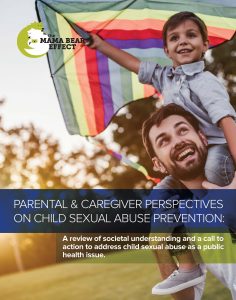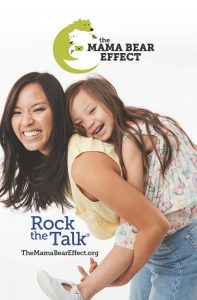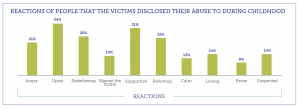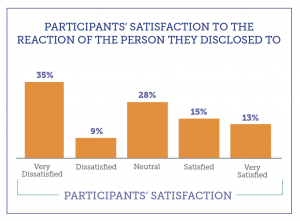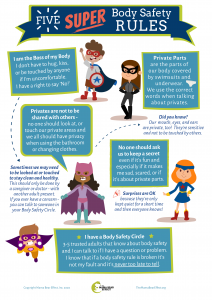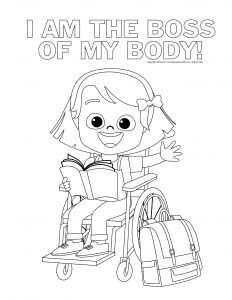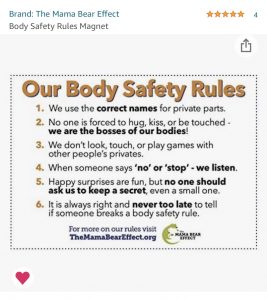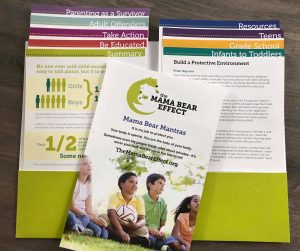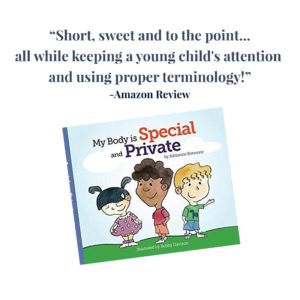Many adults, when first expressing interest in protecting children from sexual abuse ask questions about when and how to teach their children body safety. Naturally, we want to give our children the tools to protect themselves (and should, in age-appropriate ways), but rather than focusing on putting the responsibility on children to prevent abuse, a better situation would be to protect children from being in situations where they may be at risk for abuse in the first place. That’s not to say that body safety education isn’t important – it’s essential and has numerous benefits, but it’s only part of protecting children. Many people are unaware what steps to take beyond body safety, and will ask, ‘Can we reduce the risk of sexual abuse in the first place?’ In short, the answer is: we should certainly try.
Can we reduce the risk of sexual abuse?
As an analogy, teaching children body safety is similar to buckling a child in a car seat. We do it for their safety, but is that all we can do to keep children from being harmed on a car ride? As protective adults, we would also pay attention to the road to see what’s ahead, keep ourselves undistracted, and drive defensively so we can avoid possible risk of harm. Ideally, we do not want to “test” the effectiveness of a safety belt or car seat, that is a last resort, worst-case scenario.
Eyes on the Road
As adults, there is a lot that we need to know to better protect children from sexual abuse. Given that over 90% of all child sexual abuse is perpetrated by someone known to the child, it is likely, we too, may know the person as well – possibly since before our child was even born. The younger the child, statistically, the more likely a perpetrator will be a family member or someone intimately involved in the life of that child. As protectors, we need to understand what may lead a person to commit sexual abuse, what they look for in a target, and how we can possibly thwart steps to gain trust/access and commit abuse. For more just on those concepts, we recommend reading more from our site, specifically:
- Understanding Abusers (adult and juvenile)
- Red Flags of Child Predators
- Why All Abusers are Not Pedophiles
- Sexual Behaviors in Youth
Designated Drivers
It’s not possible for parents alone to protect children from sexual abuse, there is great benefit in having all the adults in a child’s life educated on this issues so they can be aware or situations that can increase risk, empower children, and be available and prepared to support a possible disclosure. Grandparents, caregivers, family friends, teachers etc., all play a role in keeping children safe. Sexual abuse can occur at the home of a family member, at a playdate, in school or camp – anywhere children are, which means it’s best that those adults be aware and take steps to create safer environments. Adults that are not aware of how easily and often sexual abuse can occur may miss opportunities to reduce risk and lack the courage to speak up even when they do feel a sense of concern.
Defensive Driving
As mentioned before, the best case scenario that we should aim for is working to minimize any opportunity for abuse to occur. But, how do we do that?
Minimizing 1:1 Situations
Statistically, we know that abuse most often occurs when the perpetrator is alone with a child, or out of sight of others. This does not necessarily mean they are in total isolation; abuse can occur in another room, or even in the same room, out of eye-sight. Some perpetrators seek a sense of power by being able to perpetrate abuse in situations where they could nearly be caught. Others, are more “cautious” about being detected and will be more controlled in their decisions as to when, where to perpetrate abuse. In a home setting, abuse can occur when a child and another adult/child are alone in a bedroom, playroom, etc. Increasing supervision by checking in on children when they are out of sight, or encouraging activities where there is better oversight, especially with a family gathering where it is easier to lose track of children and become distracted with conversation. Creating “rules” about such family gatherings that children do not play behind closed doors or that some areas of the house are off-limits will also send a message that the adults are prioritizing safety.
If children are involved in school/sports/activities, these organizations have taken on the responsibility for child safety, which includes protection from sexual abuse. Such organizations should properly screen applicants for a history of any allegations or reports of inappropriate behavior, ask specific question to applicants about the issues of child safety and be clear about prioritizing prevention of sexual abuse. There are trainings available and support from resources like Safe Kids Thrive that outline how to assess safety, create policies that reduce grey areas that can enable grooming behaviors, and establish a culture where safety and reporting are taken seriously.
Speaking Up
There are a number of ways that perpetrators can groom adults and children to gain trust, access children, and maintain control of an abusive situation so that it can continue undetected. As adults, we need to be vigilant of situations where people may seek to break down boundaries with children to build a bond, normalize inappropriate behaviors, and keep a child from disclosing abuse. A few examples of grooming behaviors and what they can look like:
- Love-bombing is when a perpetrator showers and adult and/or child with excessing attention/praise/affection to gain trust. This can be especially true for single parents that are targeted in order to gain access to their children, but also children lacking a stable, loving home environment. Children in foster care are particularly vulnerable to abuse and trafficking.
- Real life example: a family where the father was diagnosed with a terminal-illness found that a family friend was eagerly offering friendship and support for the family by taking their child out for afternoon trips.
- Mentoring – adults that push they can help lead a child to advance academically, athletically, or other talent, etc., promoting that the child has great attention but that they are the one to guide that child and give them extra attention and focus to get there. This will often lead to 1:1 situations, possible trips alone with the child.
- Real life example: a teacher began emailing a middle school student and the parents to inform them that the teacher felt the student had great potential and wanted to tutor the student after school. The emails were persistent and the parents were especially concerned as it was only the beginning of the school year and the teacher had no evidence to gauge the potential of the child.
- Real life example: an acting coach that promised fame for a child actor, pushing for private photoshoots and casting calls without the parents present
- Gift Giving & Special Treatment – a perpetrator may seek to win children over with toys, candy, money, or special treatment – allowing them to do things other cannot: staying up late, watching restricted shows, or even illegal behaviors, such as drinking alcohol. While some of these behaviors may be expected based on certain relationships, like a grandparent giving gifts, it may not be typical for other adults, especially those in a position of authority, like a teacher, coach, or neighbor.
- A school principal that would “reward” children by having lunch in his office without other adults present or able to observe the interaction.
- Inappropriate Behaviors – while many believe that grooming occurs out of sight of others, it often occurs in plain-view as this can help to normalize the behavior with the targeted child. If other adults are not stepping in, then it must be acceptable. Inappropriate behaviors may include – a teacher or instructor tickling or being affectionate with children beyond expectation. (This is where clear policies can help.) Adults or juveniles that talk with children about concepts beyond their age-level; conversations about sex, romantic relationships, drugs/alcohol, etc. are not something they should be discussing with children.
- Real life example: An elementary gym teacher that allowed students to sit on his lap during class.
- Real life example: A swim instructor that would talk about her relationships to children in her class.
- Secrets – anytime a child is encouraged or told to keep a secret from parents or protective adults, it weakens their bond. Even if a secret seems happy or harmless (like keeping a “secret” about a gift) it’s important for children to clearly know the difference between surprises – that are always happy and only kept quiet for a short time, and secrets that are not meant to be told.
- Real life example: A child that made a mess and was told by her aunt that she would “keep it a secret” so her parents wouldn’t know.
- Real life example: A coach that secretly gave his cell phone number to an adolescent athlete
As adults, we can take steps to thwart perpetrators grooming children by speaking up about a situation that raises a sense concern, that can confuse children from knowing what is appropriate behavior, and increase vulnerability for abuse. Granted not all behaviors that can be considered grooming are ill-intentioned – grooming is designed to look loving, well-intentioned and harmless. As adults, we bear the burden of having to decide when to speak up and how to communicate our concern.
Body Safety Check-ins
Disclosing sexual abuse is difficult for people of any age. It should not be assumed that children will innately know to tell or have the courage to do so. As protective adults, we need to create an environment that encourage communication – so that if children have a question or concern, they can feel safe to talk about it. By checking in regularly, especially if children have spent time alone with others, we can reinforce the importance of body safety and our commitment to keeping children safe.
Preparing for a Disclosure
As we’ve said before, we cannot guarantee that we can prevent child sexual abuse, in the event that abuse has occurred, our goal is to encourage early disclosure and support a child as soon as they feel safe enough to tell, so that the healing process can begin. Too often, survivors are not believed and supported by the first person they told. For many, this was the first and last time they disclosed as a result of not receiving the support and compassion they needed.
As protective adults, as much as we never want to imagine sexual abuse occurring to a child we know, we must prepare ourselves for that moment so we can be there for that child. Remaining as calm as possible, listening and controlling our reaction, allowing the child to use their own words – these are all important steps to allow a child to feel comfortable talking. Telling a child that we are so glad they told us, that it’s not their fault, that we believe them – this is a crucial step in healing.
What if we suspect abuse, but a child has not disclosed? Every situation is unique and requires consultation to identify the best steps moving forward. Resources are available if you suspect or have received a disclosure. Reporting abuse does not guarantee that justice will be served or that a criminal investigation will even take place. In our commitment to truly protecting children, we acknowledge that child protection and our justice system do not always prioritize the rights and protections of children.
That said, an experience of sexual abuse does not mean a child’s life is over. The resilience of children is directly related to the support and character of the adult’s in their life, which means parents of children who have experienced abuse also need to invest in their own health and healing to best support their child. Mother’s of Sexually Abused Children is one organization committed to helping parents in the aftermath of abuse. Healing can come in many forms, not just psychological therapy but also expression and personal development through exercise/sports, the arts, writing, music, animal therapy, volunteering, and spending time in nature. Finding sources of connection and purpose and seeing how others find ways to process their feelings and find joy in life will help children build the resilience to do the same.
You may also like,
Parenting as a Survivor 5 Ways Parents can Deter Predators The Body Safety Check-in

